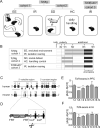Modulation of cognition and neuronal plasticity in gain- and loss-of-function mouse models of the schizophrenia risk gene Tcf4
- PMID: 33037178
- PMCID: PMC7547694
- DOI: 10.1038/s41398-020-01026-7
Modulation of cognition and neuronal plasticity in gain- and loss-of-function mouse models of the schizophrenia risk gene Tcf4
Abstract
The transcription factor TCF4 was confirmed in several large genome-wide association studies as one of the most significant schizophrenia (SZ) susceptibility genes. Transgenic mice moderately overexpressing Tcf4 in forebrain (Tcf4tg) display deficits in fear memory and sensorimotor gating. As second hit, we exposed Tcf4tg animals to isolation rearing (IR), chronic social defeat (SD), enriched environment (EE), or handling control (HC) conditions and examined mice with heterozygous deletion of the exon 4 (Tcf4Ex4δ+/-) to unravel gene-dosage effects. We applied multivariate statistics for behavioral profiling and demonstrate that IR and SD cause strong cognitive deficits of Tcf4tg mice, whereas EE masked the genetic vulnerability. We observed enhanced long-term depression in Tcf4tg mice and enhanced long-term potentiation in Tcf4Ex4δ+/- mice indicating specific gene-dosage effects. Tcf4tg mice showed higher density of immature spines during development as assessed by STED nanoscopy and proteomic analyses of synaptosomes revealed concurrently increased levels of proteins involved in synaptic function and metabolic pathways. We conclude that environmental stress and Tcf4 misexpression precipitate cognitive deficits in 2-hit mouse models of relevance for schizophrenia.
Conflict of interest statement
The authors declare that they have no conflict of interest.
Figures




References
Publication types
MeSH terms
LinkOut - more resources
Full Text Sources
Medical
Research Materials

